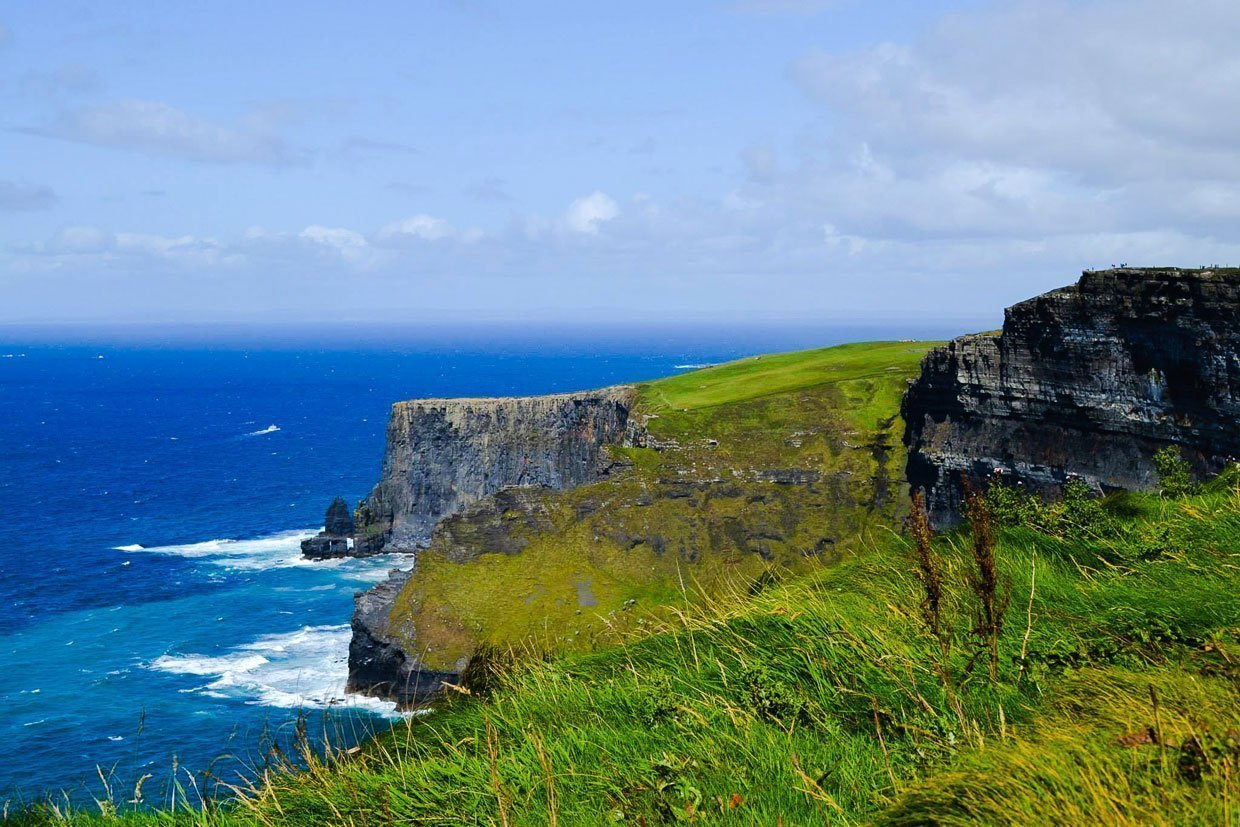To stand at the edge of the Cliffs of Moher is to feel the raw, elemental power of the planet. It is an experience that transcends the mere act of seeing a beautiful view; it is a full sensory immersion.
The air, thick with the clean, sharp scent of salt, is never still. It carries the ceaseless roar of the Atlantic Ocean as it crashes into the rock face hundreds of feet below, a sound that has echoed through millennia.
Above, the sky is a vast, often dramatic canvas, alive with the cries of thousands of seabirds that wheel and dive in the powerful updrafts.
This is Ireland’s edge, a place where the land comes to an abrupt and spectacular end, and where one feels an overwhelming sense of both grandeur and insignificance in the face of deep time.
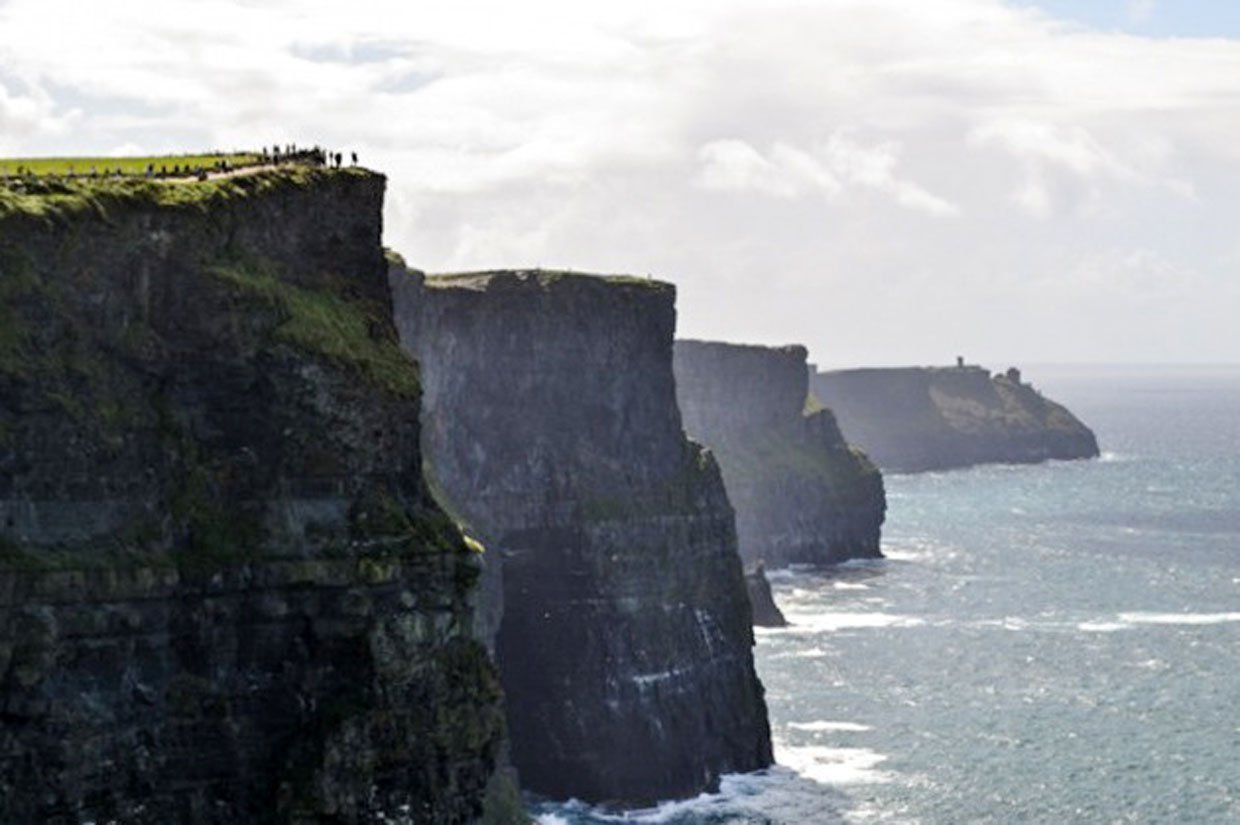
Located in County Clare along the celebrated Wild Atlantic Way, the Cliffs of Moher are a geological masterpiece.
They stretch for an astonishing 14 kilometers (8.7 miles), rising to a breathtaking height of 214 meters (702 feet) at their apex near O’Brien’s Tower.
This immense scale has earned the region recognition as a Burren and Cliffs of Moher UNESCO Global Geopark, a testament to its international geological, ecological, and cultural importance.
Yet, the cliffs are more than just a magnificent natural formation. They are a palimpsest, layered with meaning.
They are a 320-million-year-old story written in stone, a landscape steeped in myth and folklore that whispers tales of witches and lost cities, and a cinematic icon that has captured the imagination of millions around the globe.
To visit the Cliffs of Moher is to engage with all these layers, to stand on a frontier not just between land and sea, but between the present and an ancient, powerful past.
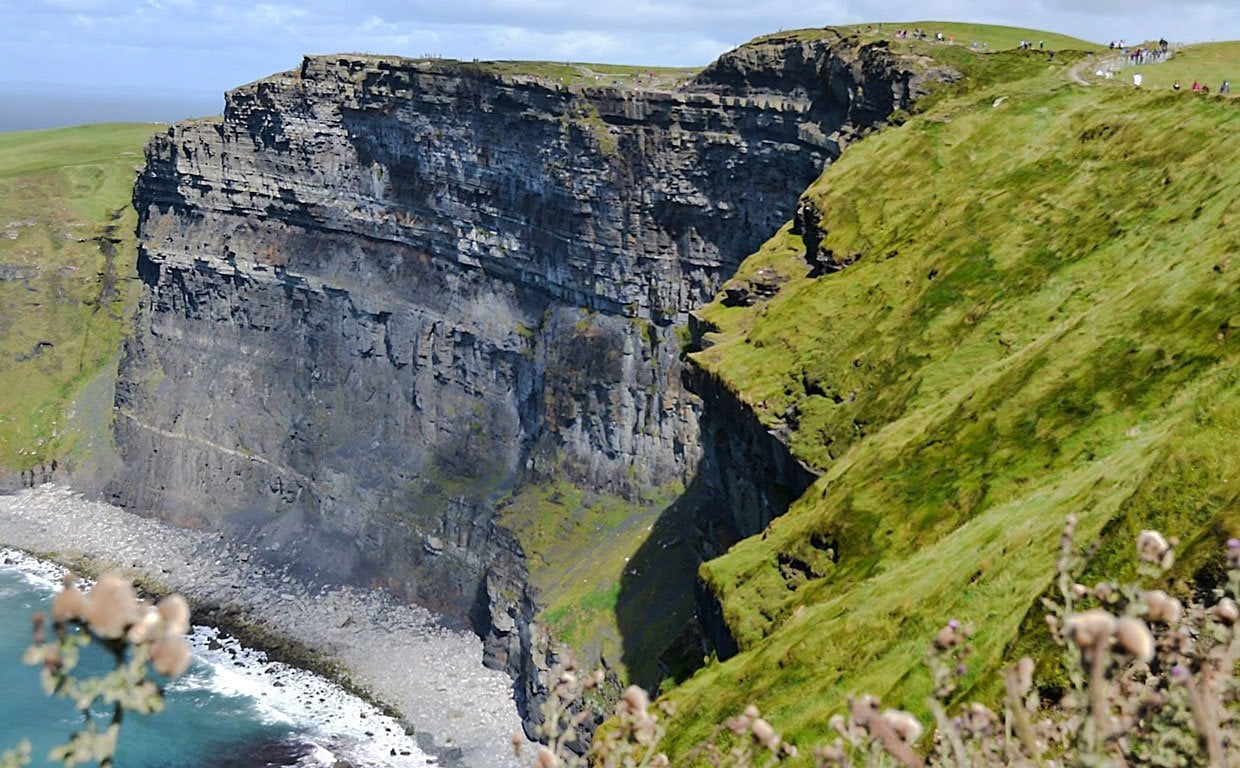
The Story of Stone and Soul
A 320-Million-Year Epic: Reading the Rock
The story of the Cliffs of Moher begins not in the cold North Atlantic, but in a warm, shallow sea near the Earth’s equator some 320 million years ago, during the Upper Carboniferous period.
At that time, the landmass that would become Ireland enjoyed a climate akin to the modern-day Bahamas. An enormous ancient river, flowing from mountains long since eroded to dust, emptied into this sea, creating a vast delta.
For millions of years, this river deposited immense quantities of sand, silt, and mud, which settled on the seabed in successive layers.
Over eons, the immense pressure of the water and subsequent deposits compacted these sediments into the distinct horizontal bands of rock—or strata—that define the cliffs today: the lighter, more resistant layers of sandstone and the darker, softer layers of siltstone and shale.
From their tropical birthplace, these rock formations embarked on an epic, imperceptibly slow journey. Carried on the back of a giant tectonic plate, they drifted 6,000 km north at a pace of just two centimeters per year.
During this long, bumpy voyage, the plate collided with another, an event of unimaginable force that buckled and fractured the rock. This collision created the deep, vertical fissures that give the cliffs their iconic sheer face.
These fractures are lines of weakness, and it is along these lines that the cliffs calve today, falling away in great sheets to create their perpendicular, awe-inspiring profile.
More recently, the landscape was subjected to the sculpting power of ice and water. During the last Ice Ages, great sheets of frozen water hundreds of meters thick scoured the region, planing the hillsides into escarpments.
As the ice retreated, the Atlantic Ocean began its relentless work. The constant battery of waves attacks the base of the cliffs, carving out caves and undercutting the rock. When a cave erodes all the way through a headland, a sea arch is formed.
When the top of that arch collapses, it leaves behind a solitary sea stack, a stone pillar standing defiant against the waves.
The famous An Branaunmore sea stack, which rises 67 meters from the water, is a testament to this ongoing process of creation through destruction.
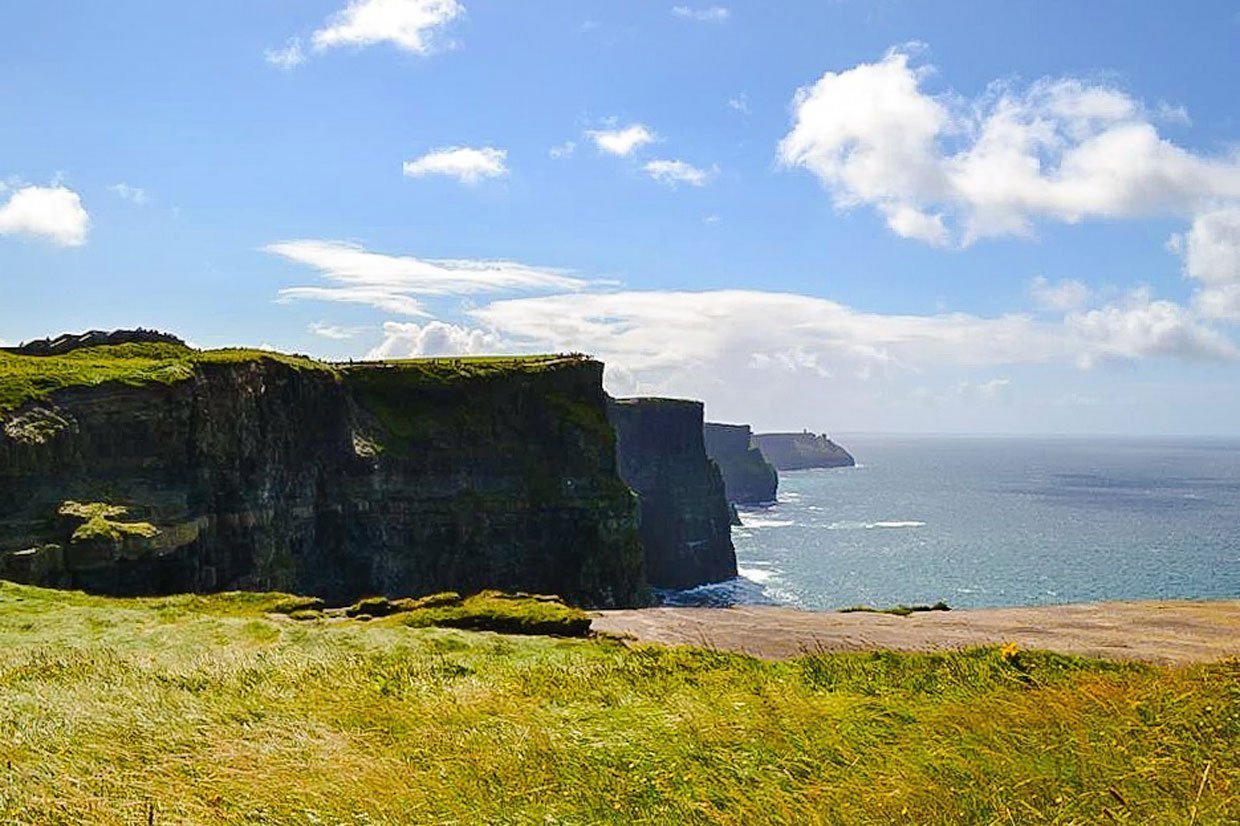
This dynamic is a fundamental paradox of the cliffs: their breathtaking beauty is a direct consequence of their slow, inevitable demise. They are not a static monument but a live geological battleground where the ancient rock is in a constant, dramatic struggle with the sea.
The stones themselves hold more intimate stories. Embedded within the shale layers are the fossilized remains of marine creatures like ammonoids and crinoids, echoes of the ancient sea.
The flagstones used to pave the paths of the Visitor Centre, quarried locally as Liscannor Stone, are famous for the squiggly patterns that trace their surface.
These are not decorative carvings, but trace fossils—the preserved burrows and feeding trails of mysterious organisms that lived in the mudflats 320 million years ago, their exact identity still unknown to science.
To walk on these stones is to literally tread upon the history of this ancient world.
Whispers on the Wind: The Legends of Moher
Where the geological record ends, folklore begins, weaving a rich tapestry of meaning into the landscape.
The very name of the cliffs is rooted in human history, derived from the old Gaelic term ‘Mothar’, which referred to a fort that once stood at the southernmost point, a place now known as Hag’s Head. Though the fort itself is long gone, its name endures.
That promontory, Hag’s Head, is the setting for one of the cliffs’ most dramatic legends: the tale of the witch Mal. Mal, it is said, fell madly in love with the legendary Irish hero Cú Chulainn.
He did not return her affections and fled from her, leading her on a chase across all of Ireland.
The pursuit ended at the mouth of the River Shannon, where Cú Chulainn leaped to a nearby sea stack. Mal, in her desperation, leaped after him, a gust of wind carrying her safely across.
Cú Chulainn promptly leaped back to the mainland. Mal, emboldened but without the aid of the wind this time, attempted to follow but fell short, crashing into the rocks below.
The bay was stained with her blood, giving rise to the name Malbay, and the cliff profile at the southern end of the cliffs is said to have taken on the shape of her face, forever known as Hag’s Head.
The folklore of the cliffs is not merely a collection of stories, but a form of deep mapping, connecting narrative directly to the topography.
The legend of the Lost City of Kilstiffen tells of a great chieftain who lost the golden key to his castle, causing the entire city to be submerged beneath the waves off Liscannor Bay.
The city, it is said, will only reappear when the key is found, though some claim it rises from the depths once every seven years.
To witness this magical event, however, is a death sentence, as the viewer will not live to see it rise again.
This potent myth finds a basis in reality, likely inspired by the very real submerged forests and ancient bogs that can be seen under the water in the bay on calm days, a folk explanation for a geological phenomenon.
Similarly, a specific stretch of cliffs north of O’Brien’s tower is known as Aill na Searrach—the Leap of the Foals.
This name comes from the legend of the Tuatha Dé Danann, the pantheon of Celtic gods who ruled Ireland before the arrival of Christianity.
Angered by their displacement, they transformed themselves into horses and hid for centuries in a deep cave.
When seven young foals finally emerged, they were so startled by the sunlight after an age of darkness that they panicked, galloped along the cliff edge, and plunged to their deaths.
This story anchors a pivotal moment of cultural change in Ireland directly to the landscape.
Even the famous giant wave, Aileen’s Wave, a mecca for big-wave surfers that breaks near this spot, is sometimes linked to the legend, with some claiming to see the ghostly shapes of horses riding in its crest.
These stories demonstrate how folklore serves as the land’s oral history, a way for generations to understand, remember, and respect their powerful and often dangerous environment.
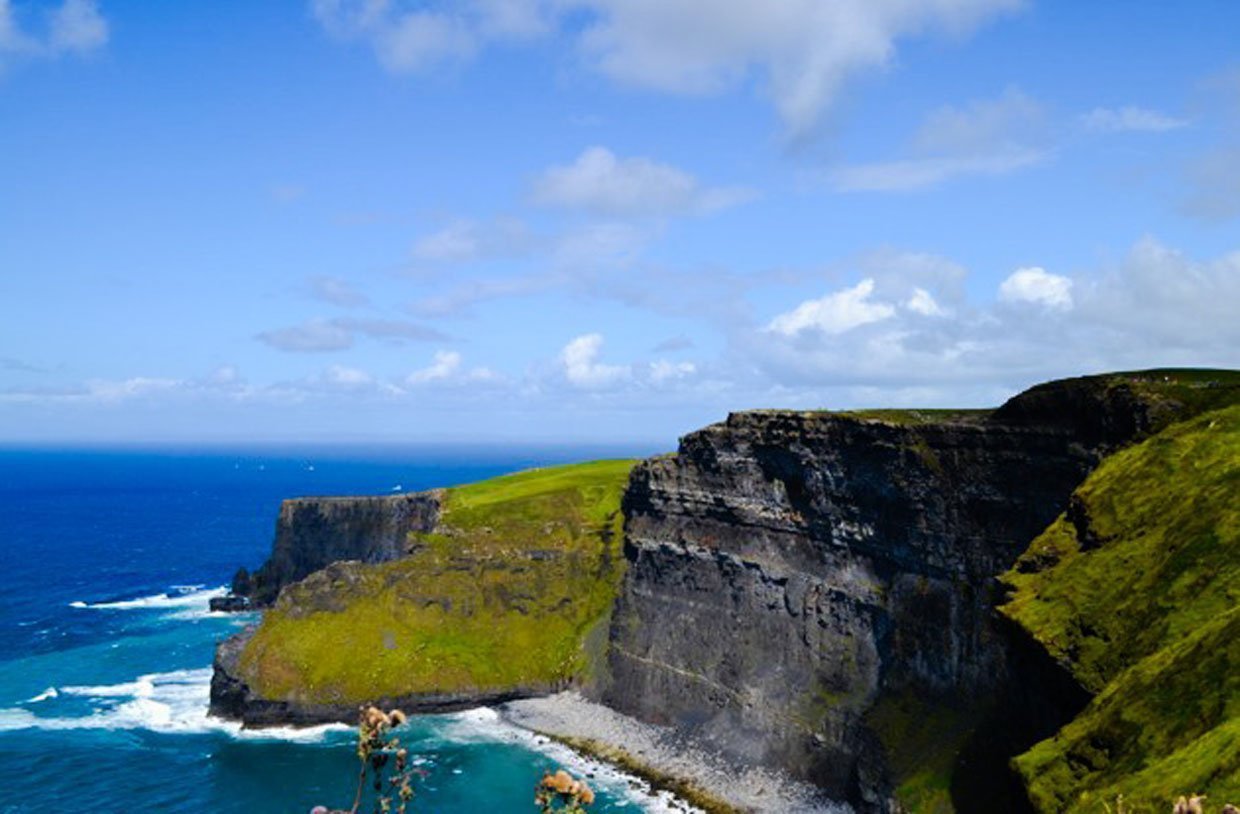
The Wild Heart of the Cliffs
A City of Wings: Ireland’s Great Seabird Colony
The Cliffs of Moher are more than just rock; they are a vibrant, vertical metropolis of seabirds. Designated as a Special Protection Area (SPA) under EU law, the cliffs are one of Ireland’s most vital bird-breeding sites, hosting a clamorous, thriving colony of over 30,000 pairs of nesting seabirds across more than 35 different species.
The air thrums with their activity, a constant chorus of calls and the beat of countless wings.
The undisputed stars of this avian city are the Atlantic Puffins. With their sad-eyed expressions, formal black-and-white plumage, and dazzlingly colourful beaks, they are often called the “clowns of the sea”.
These birds spend most of their lives on the open ocean, returning to the cliffs each spring to breed. They are monogamous and often return to the same partner and the same burrow year after year.
Rather than nesting on the precarious rock ledges, puffins dig burrows into the soft soil of the grassy clifftops, with Goat Island, a promontory below O’Brien’s Tower, being a particularly popular puffin neighbourhood.
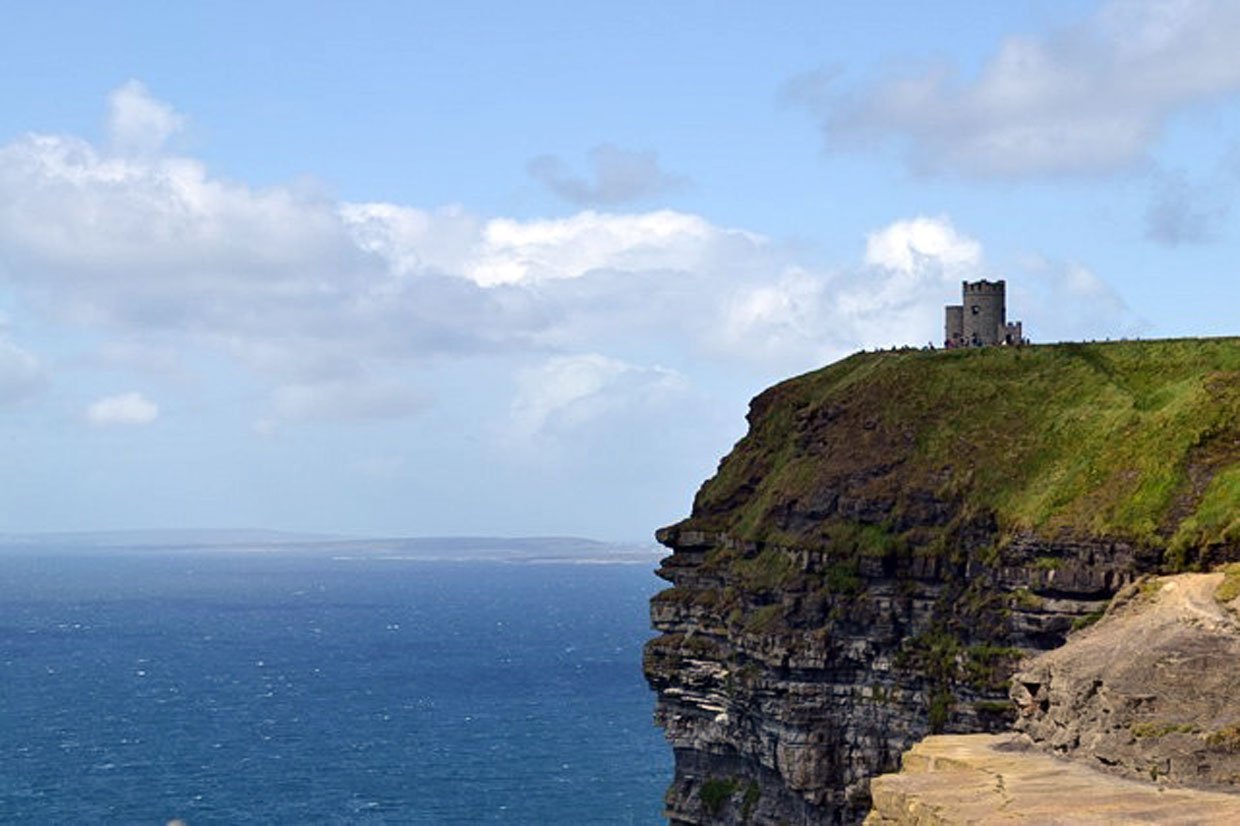
A recent discovery has added to their mystique: their brightly coloured summer beaks are fluorescent, glowing under UV light, a trait thought to be related to courtship.
Sharing the cliffs are other members of the Auk family, including Razorbills and Guillemots.
These birds prefer to nest on the impossibly narrow ledges of the sheer rock faces, particularly on the Great Sea Stack, An Branaunmore.
They pack themselves tightly onto the ledges, their sheer numbers a formidable sight. The cliffs are also home to noisy colonies of Kittiwakes and Fulmars, whose calls are a signature part of the soundscape.
For any visitor hoping to witness this spectacle, timing is everything. The seabirds begin to arrive in late March and April. The peak breeding season, when the cliffs are at their busiest and most vibrant, is from May through June.
By early August, most of the birds, including the puffins and their newly fledged “pufflings,” will have departed, returning to their life at sea.
Beyond the bustling bird colonies, other wildlife makes its home here. The waters below are a rich feeding ground, and patient observers on calm days may be rewarded with the sight of breaching basking sharks, pods of playful dolphins, or the sleek heads of grey seals.
On the landward side, foxes, hares, and even feral goats roam the landscape.
Life on the Ledge: The Resilient Flora of the Coast
The biodiversity of the cliffs is a story of extreme adaptation, a testament to life’s tenacity in one of Europe’s most challenging coastal environments.
The Burren and Cliffs of Moher Geopark is a botanical paradox. This seemingly harsh, rocky landscape is home to an astonishing 75% of Ireland’s native flora, over 700 species in total.
Most remarkably, it is one of the few places on Earth where Arctic-alpine plants, such as the delicate Spring Gentian, grow side-by-side with warmth-loving Mediterranean species, like the Dense-flowered Orchid.
This unique assemblage is made possible by the specific geology and mild, damp climate. The limestone bedrock provides calcium-rich soil, while in some areas, like the cliffs themselves, this is capped with a layer of shale, creating lime-free, acidic soil.
This allows for an incredible diversity of plant life to thrive in close proximity. The plants that cling to the cliff edges have evolved to survive the constant, salt-laden winds. Species like Sea Pinks (also known as Thrift), Sea Campion, and Plantain grow low to the ground in dense cushions to resist the gales. In spring and early summer, these hardy wildflowers transform the clifftop grasslands into a tapestry of colour.
This vibrant flora is the foundation of a complex local ecosystem. The native plants are the specific food source for a variety of insects, including 28 of Ireland’s 30 butterfly species.
The Marsh Fritillary butterfly, for example, relies on the Devil’s Bit Scabious that grows along the grassy banks. These insects, in turn, become a crucial food source for the nesting birds, completing a delicate web of life.
The cliffs are not merely a backdrop for this wildlife; they are an active participant, a shaping force that has forged a community of uniquely resilient and adapted organisms.
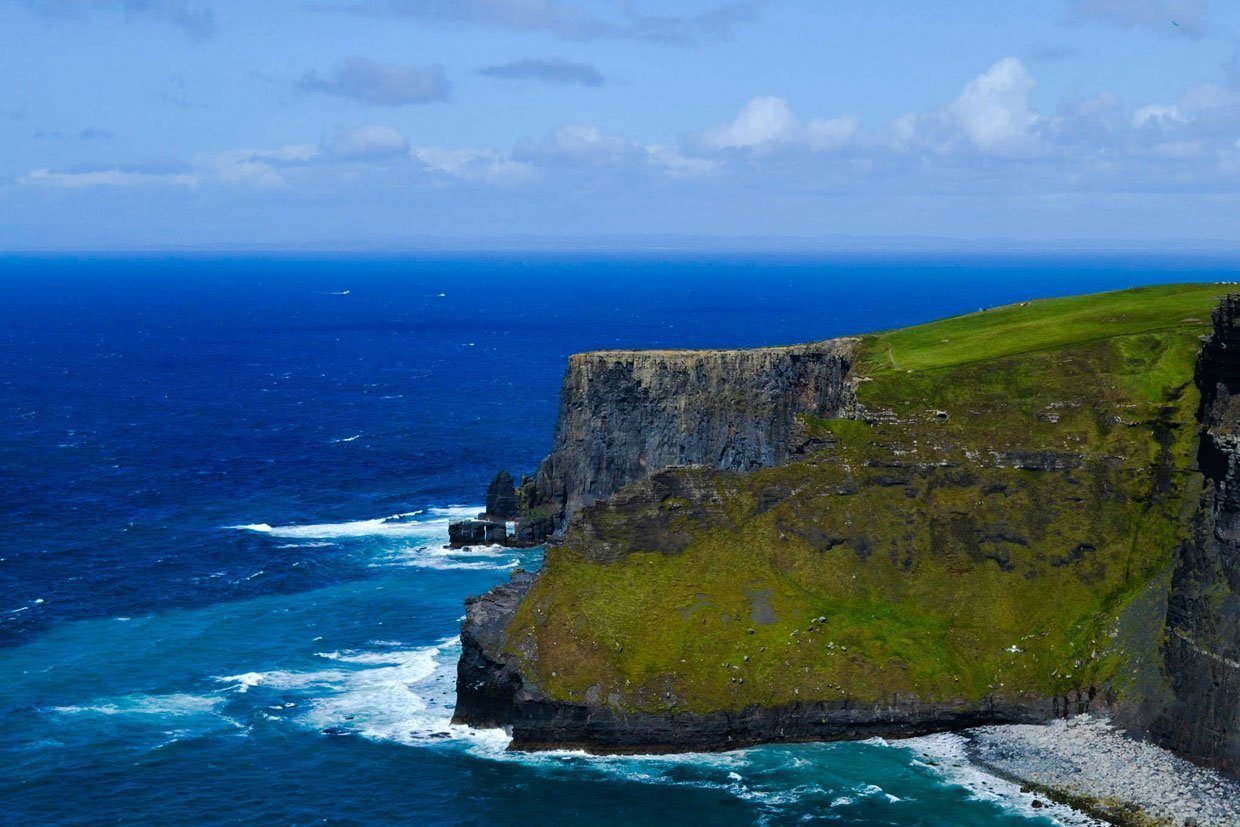
Your Definitive Guide to the Cliffs of Moher Experience
Planning Your Pilgrimage: Getting There and When to Go
Reaching the Cliffs of Moher is a journey to the western edge of Ireland, and planning is key to a rewarding visit.
From Dublin, the drive takes approximately 3 hours, while public transport options involving a train or bus via Galway or Limerick and Ennis can take between 5 and 6 hours.
Bus Éireann’s Route 350 is a key public service connecting Galway, the cliffs, and Ennis, and numerous private coach companies offer all-day tours from Dublin.
For those starting from closer hubs like Galway or Limerick, the cliffs are a much more manageable day trip, with public buses and dedicated half-day express tours available.
The timing of a visit can dramatically shape the experience. Each season offers a different character. Spring (March-May) brings blooming wildflowers, the return of the seabirds, and fewer crowds.
Summer (June-August) provides the warmest weather and longest daylight hours but coincides with the peak tourist season and the largest crowds.
Autumn (September-November) offers a reprieve from the summer rush, with mild weather and beautiful colours. Winter (December-February) promises solitude and dramatic, moody seascapes, but visitors must be prepared for cold, wet, and windy conditions with limited daylight.
Perhaps the most crucial piece of advice for any visitor is to time the visit to avoid the midday rush. The cliffs are busiest between 11 am and 4 pm, when the majority of tour buses arrive.
A visit in the early morning or late afternoon not only offers a more peaceful and personal experience but also provides the best light for photography.
As the cliffs face west, the “golden hour” before sunset can bathe the landscape in a truly magical glow.
Table 1: Cliffs of Moher Visitor Experience at a Glance
| Season | Opening Hours | Adult Price (Online) | Senior/Student Price (Online) | Family & Child Prices |
| Summer (May-Aug) | 8:00 am – 9:00 pm | From €8.00 | From €6.00 | Child (U12) Free; Family from €16.00 |
| Shoulder (Mar, Apr, Sep, Oct) | 8:00 am – 7:00 pm | From €8.00 | From €6.00 | Child (U12) Free; Family from €16.00 |
| Winter (Nov-Feb) | 9:00 am – 5:00 pm | From €8.00 | From €6.00 | Child (U12) Free; Family from €16.00 |
Note: The Cliffs of Moher Experience is closed on December 24th, 25th, and 26th. Prices reflect online booking, which offers the best rates; prices are lower for off-peak time slots (before 11 am and after 4 pm). Children under 12 are free when accompanied by a parent/guardian.
The Official Experience: Navigating the Visitor Centre and Key Viewpoints
The modern Cliffs of Moher Experience is a masterclass in design, carefully constructed to manage the flow of over a million visitors a year while minimizing its impact on the delicate landscape.
The award-winning Visitor Centre is cleverly built into the hillside, its grass roof making it resemble a “Hobbit-hole” that blends almost seamlessly into the scenery.
Inside this subterranean hub, a central dome houses an interactive exhibition organized around four themes: Ocean, Rock, Nature, and Man.
Here, visitors can delve into the geology, wildlife, and human history of the cliffs. A highlight is “The Ledge 4D Experience,” a thrilling virtual reality adventure that simulates a flight along the cliff face and a dive beneath the waves, offering a gannet’s-eye view of this dynamic environment.
The centre is fully accessible and includes a range of amenities: two cafés (the ground-floor Puffin’s Nest and the first-floor Cliffs View Café), gift shops stocking local Irish crafts, restrooms, Wi-Fi, and luggage storage. For visitors with mobility challenges, the “Lifts of Moher” service provides an electric vehicle to ensure access to the main viewing areas.
From the centre, 800 meters of safe, paved pathways lead to the primary viewing platforms. The Main Platform offers the iconic postcard vista looking south towards the sea stack and Hag’s Head.
The North Platform, near O’Brien’s Tower, is the highest point of the cliffs and on a clear day provides panoramic views that can stretch to the Aran Islands in Galway Bay and the Twelve Bens mountains in Connemara.
The South Platform is the prime location for viewing the bustling puffin colony on Goat Island during the breeding season. Crowning the highest point is O’Brien’s Tower, a folly built in 1835 by the visionary local landowner Sir Cornelius O’Brien as an observation point for the first wave of Victorian tourists.
For a small additional fee, visitors can climb the tower for the most commanding views of all.
Two Paths to Wonder: Exploring by Foot and by Sea
For many, the “Cliffs of Moher Experience” is a negotiation between the allure of the wild, untamed edge and the comfort of curated safety.
The site offers distinct ways to engage with this tension, allowing visitors to choose their own level of adventure.
The Cliffs of Moher Coastal Walk offers the most intimate and exhilarating way to experience the landscape. However, safety is a major concern, and sections of this trail are subject to closure.
As of mid-2025, the entire southern section of the walk from Liscannor and Hag’s Head to the Visitor Centre is fully closed due to severe safety concerns.
The northern section is only partially open, allowing walkers to go from the village of Doolin as far as the Surfers Path, at which point they must turn back. This strenuous section of the trail involves steep inclines but rewards hikers with spectacular, evolving views.
For those seeking a richer and safer experience on this section, guided walks led by local farmers, such as Pat Sweeney, offer unparalleled insight into the area’s history and ecology.
An entirely different, yet equally spectacular, perspective is offered by the boat tours that depart from Doolin Pier.
Viewing the cliffs from sea level is the only way to truly comprehend their colossal scale and sheer verticality.
A boat cruise brings visitors right to the base of the Great Sea Stack, offers the best and closest views of the nesting seabird colonies, and provides a glimpse into the sea cave that served as the location for Voldemort’s Horcrux in Harry Potter and the Half-Blood Prince.
It is an essential complementary experience to the clifftop view, revealing a side of the cliffs that is otherwise hidden.
Essential Field Notes: Safety, Attire, and Capturing the Moment
A visit to the Cliffs of Moher requires respect for the power of nature. Safety is paramount. The cliff edges are unstable and prone to collapse, and sudden, powerful gusts of wind are common.
Visitors must adhere to all safety warnings, stay on the official designated paths, and never cross barriers for a photograph. The site follows the official Met Éireann weather warning system; under a Status Orange or Red warning, the site will be closed for safety.

Appropriate attire is non-negotiable. The weather on the west coast of Ireland is notoriously changeable, and one can experience four seasons in a single hour.
Dressing in layers is essential, with the outermost layer being both waterproof and windproof. Sturdy, comfortable walking shoes with good grip are a must, as paths can be uneven and slippery when wet.
Umbrellas are useless in the strong winds and should be left behind in favour of a hooded jacket.
For photographers, the cliffs offer endless inspiration. The best light is typically in the late afternoon and evening, as the setting sun illuminates the west-facing cliffs.
However, one should not be discouraged by inclement weather; fog, mist, and rain can create incredibly dramatic and atmospheric images.
Due to the powerful and unpredictable winds, using a tripod is risky and generally not recommended.
Beyond the Brink: The Soul of County Clare
To treat the Cliffs of Moher as a standalone attraction is to see a masterpiece without its frame.
The cliffs are the magnificent centerpiece of a rich and interconnected cultural and geological ecosystem that defines this corner of County Clare. To truly experience their magic, one must explore the surrounding landscape.
Doolin: The Heartbeat of Irish Music
Just a few kilometers north of the cliffs lies the charming coastal village of Doolin, celebrated globally as the “home of traditional Irish music”.
Its brightly painted cottages are home to a handful of legendary pubs where, every night of the week, some of Ireland’s finest musicians gather for lively, informal sessions.
The “holy trinity” of Doolin pubs—Gus O’Connor’s (est. 1832), McDermott’s Pub, and McGann’s Pub—form the vibrant heart of this scene, offering visitors an authentic and unforgettable cultural experience. In recent years,
Doolin has also become a culinary destination, with a food scene that ranges from hearty pub grub like fresh fish and chips to Michelin-guide-recommended fine dining at restaurants like Oar and Homestead Cottage, which champion the best of local and foraged ingredients.
The Burren: A Lunar Landscape of Stone and Flower
The Cliffs of Moher form the western boundary of a truly unique landscape: the Burren. The name comes from the Irish word Boíreann, meaning “a rocky place,” a fitting description for this vast, 360-square-kilometer region of limestone pavement.
This is a karst landscape, formed over millennia as acidic rainwater dissolved the limestone, creating a surreal terrain of deep fissures (grikes) and exposed slabs of rock (clints).
The Burren National Park, located in the southeastern corner of the region, offers a network of way-marked trails, like the popular Mullaghmore Loop, that allow visitors to walk across this otherworldly “lunar” landscape.
Despite its barren appearance, the Burren is a place of incredible biodiversity, ancient megalithic tombs, and unique farming traditions, offering a profound contrast to the vertical drama of the cliffs.
The Aran Islands: A Voyage to the Edge of Time
Looking west from the cliffs, the three Aran Islands lie on the horizon, marking the mouth of Galway Bay. Doolin Pier serves as the primary gateway to these islands, offering the shortest and fastest ferry crossings.
A day trip to the islands is a journey back in time to a place where the Irish language (Gaeilge) is still spoken, and a traditional way of life endures amidst a labyrinth of ancient stone walls and prehistoric forts.
Each of the three islands offers a distinct experience, allowing visitors to choose their own adventure.
Table 2: Choosing Your Aran Island
| Island | Nickname / Size | Atmosphere | Key Historical Sites | Best For |
| Inis Mór | “The Big Island” / Largest | Bustling, most amenities, popular with tourists | Dún Aonghasa (prehistoric cliff fort), The Black Fort, The Wormhole (Poll na bPéist) | Visitors seeking the most attractions, activities, and services. |
| Inis Meáin | “The Middle Island” / Quietest | Tranquil, traditional, an escape from modernity | Dún Chonchúir (well-preserved stone fort), Synge’s Chair | Travellers seeking solitude, authenticity, and a glimpse of old Ireland. |
| Inis Oírr | “The East Island” / Smallest | Charming, compact, easily explored | O’Brien’s Castle, MV Plassey Shipwreck, Teampall Caomhán (sunken church) | Day-trippers from Doolin looking for a manageable and scenic experience. |
The Enduring Impression: The Cliffs in Culture
The sheer dramatic power of the Cliffs of Moher has cemented their place not only as a natural wonder but as a global cultural icon.
For millions, the first encounter with their breathtaking scale was on the silver screen. They are the mythical “Cliffs of Insanity” that the Man in Black scales so heroically in the 1987 classic The Princess Bride.
They are the foreboding, storm-lashed location of the sea cave where Harry Potter and Dumbledore hunt for one of Voldemort’s Horcruxes in
Harry Potter and the Half-Blood Prince. Their rugged beauty has also provided a backdrop for romantic comedies like Leap Year and music videos for international artists like Maroon 5 and Irish superstars Westlife.
Conclusion
This presence in popular culture speaks to the universal awe the cliffs inspire. They are at once a geological textbook, a storybook of ancient myths, a thriving and resilient ecosystem, and a world-class travel destination. To visit them is to experience a landscape that is simultaneously immense and intimate, terrifying and beautiful, ancient and ever-changing.
A journey to the Cliffs of Moher is more than a stop on an itinerary; it is a profound encounter with the wild majesty of the Atlantic frontier, a memory of standing at the edge of the old world that will endure long after the journey home.
There is no way to capture the experience of standing on the edge of the cliffs it is truly a moment I will not forget.

